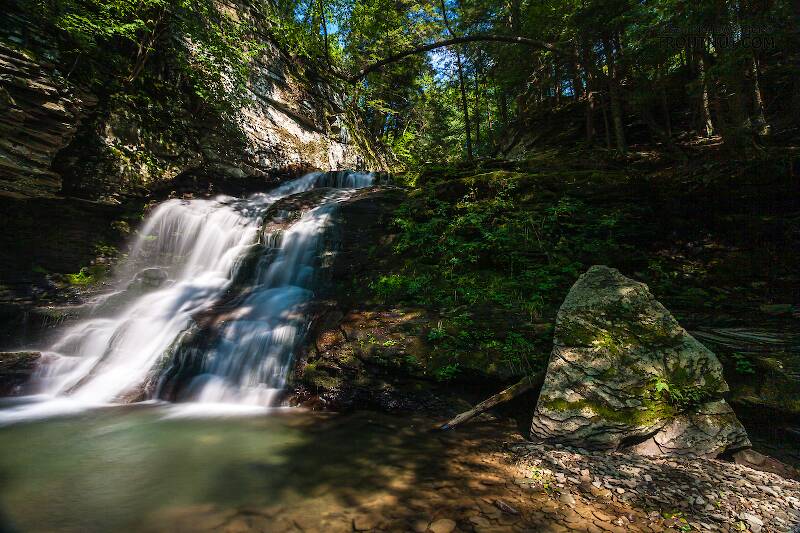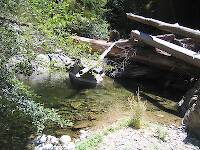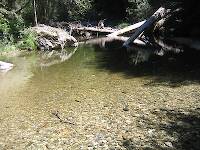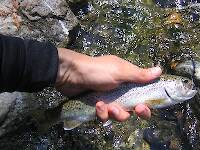
Blue-winged Olives
Baetis
Tiny Baetis mayflies are perhaps the most commonly encountered and imitated by anglers on all American trout streams due to their great abundance, widespread distribution, and trout-friendly emergence habits.
Featured on the forum

This specimen resembled several others of around the same size and perhaps the same species, which were pretty common in my February sample from the upper Yakima. Unfortunately, I misplaced the specimen before I could get it under a microscope for a definitive ID.

Troutnut is a project started in 2003 by salmonid ecologist Jason "Troutnut" Neuswanger to help anglers and
fly tyers unabashedly embrace the entomological side of the sport. Learn more about Troutnut or
support the project for an enhanced experience here.
Gt2003 on Oct 18, 2007October 18th, 2007, 1:02 am EDT
Boy, you all sure make this easy. I'll follow your advice and see how things progress. Thanks again, Greg
Dano on Oct 18, 2007October 18th, 2007, 3:55 am EDT
Glad to see you getting back into the "swing of things"....
FWIW, the actual tapers do vary slightly from manufacturer to manufacturer. What is "standard" is the weighting; #of grains in the first 30'.
Typically, though, on a WF line the taper at it's front is less than the taper at the back, thus giving it better "shootability" and making it easier to cast when the wind is up. Also, the taper lengths on a DT line is generally longer than that on a WF, this is where delicacy does come into play. For example the SA Ultra4 WF-6-F specs are:
Tip Front taper Belly Rear taper Total head Running line Total
.5' 6.0' 28.0' 4.0' 38.0' 47.0' 85'
Ultra4 DT-6-F
Tip Front taper Belly Rear taper Total head Running line Total
.5' 6.5' 72.0' 6.5' N/A N/A 85'
A WF line is definetly the way to go for the beginning flycaster, as your flycasting skills improve you may want to consider adding a DT to your arsenal (roll casting a DT is easier than a WF). Also, I would add that leader length is more a function of water conditions than rod length particularly when wet/nymph fishing where control is critical. On the Klamath River in the early season, leader lengths of 3' are the norm, not the exception....
Any who, tie on a fly, clip off the hook, practice, practice, practice; your outings will be much more enjoyable....
Dano
Edit in: Sorry 'bout that, can't seem to "line up" the specs under the headings....but I think you can figure it out.
FWIW, the actual tapers do vary slightly from manufacturer to manufacturer. What is "standard" is the weighting; #of grains in the first 30'.
Typically, though, on a WF line the taper at it's front is less than the taper at the back, thus giving it better "shootability" and making it easier to cast when the wind is up. Also, the taper lengths on a DT line is generally longer than that on a WF, this is where delicacy does come into play. For example the SA Ultra4 WF-6-F specs are:
Tip Front taper Belly Rear taper Total head Running line Total
.5' 6.0' 28.0' 4.0' 38.0' 47.0' 85'
Ultra4 DT-6-F
Tip Front taper Belly Rear taper Total head Running line Total
.5' 6.5' 72.0' 6.5' N/A N/A 85'
A WF line is definetly the way to go for the beginning flycaster, as your flycasting skills improve you may want to consider adding a DT to your arsenal (roll casting a DT is easier than a WF). Also, I would add that leader length is more a function of water conditions than rod length particularly when wet/nymph fishing where control is critical. On the Klamath River in the early season, leader lengths of 3' are the norm, not the exception....
Any who, tie on a fly, clip off the hook, practice, practice, practice; your outings will be much more enjoyable....
Dano
Edit in: Sorry 'bout that, can't seem to "line up" the specs under the headings....but I think you can figure it out.
Flybinder on Oct 18, 2007October 18th, 2007, 1:42 pm EDT
"Gore"................ it's been very interesting to follow this particular post, so far, thank you for starting it!
After throwing the long rod now, for a hair over 40 years or so, it's always great to learn new things as I stumble along, which I've actually done, on lines, etc. with the post you started!
Now, when you're ready for "line #2", (don't worry, you'll soon be up to "line #27, before too much longer!), I'd suggest looking very closely at the new "Airflo brand "Ridgeline".
At the beginning of this season, I was given 4 of these, in weights WF4/F, to WF6/F,to try out and give feedback on. Well, after spooling up the WF4/F, on my Abel reel, I took it out and have "never looked back"!
In the off chance, the bride walks in while I type this, I won't say "how many" fly lines I own, my marriage is sorta solid at the moment because I also mowed the grass today. But, the new "Ridgeline" is about one of the neatest and most well designed fly lines I've ever used.I haven't taken out another line from my arsenal all season, since getting these to try!
They cast farther, when in wind, roll cast like no other, WF I've ever rolled with, self clean on every cast and even my 4wts turn over 7' Bass Leaders and deer hair, Bass bugs no problem!
My stomping grounds, for fishing, are Oregon, (home state), but also Washington, Idaho and Montana on equal basis all season long, so I never know if I'll be on short water, long water, lakes,rivers, or streams on a given outing. But, after loading up the Ridgelines, I've never worried about where I'm fishing, when it's come to re-spooling a reel.
Because of their design, they don't touch the rod's guides, like conventional lines, thus also, keeping down the wear friction on snakes and tip top, especially like old style lines that collect algae and water scum.
Of course, like any board, on any topic, when 2 or more anglers get together........................these are only MY OWN comments, suggestions and ideas, on a given piece of gear!
Thanks, again, for a really good topic!
After throwing the long rod now, for a hair over 40 years or so, it's always great to learn new things as I stumble along, which I've actually done, on lines, etc. with the post you started!
Now, when you're ready for "line #2", (don't worry, you'll soon be up to "line #27, before too much longer!), I'd suggest looking very closely at the new "Airflo brand "Ridgeline".
At the beginning of this season, I was given 4 of these, in weights WF4/F, to WF6/F,to try out and give feedback on. Well, after spooling up the WF4/F, on my Abel reel, I took it out and have "never looked back"!
In the off chance, the bride walks in while I type this, I won't say "how many" fly lines I own, my marriage is sorta solid at the moment because I also mowed the grass today. But, the new "Ridgeline" is about one of the neatest and most well designed fly lines I've ever used.I haven't taken out another line from my arsenal all season, since getting these to try!
They cast farther, when in wind, roll cast like no other, WF I've ever rolled with, self clean on every cast and even my 4wts turn over 7' Bass Leaders and deer hair, Bass bugs no problem!
My stomping grounds, for fishing, are Oregon, (home state), but also Washington, Idaho and Montana on equal basis all season long, so I never know if I'll be on short water, long water, lakes,rivers, or streams on a given outing. But, after loading up the Ridgelines, I've never worried about where I'm fishing, when it's come to re-spooling a reel.
Because of their design, they don't touch the rod's guides, like conventional lines, thus also, keeping down the wear friction on snakes and tip top, especially like old style lines that collect algae and water scum.
Of course, like any board, on any topic, when 2 or more anglers get together........................these are only MY OWN comments, suggestions and ideas, on a given piece of gear!
Thanks, again, for a really good topic!
Flybinder:
"You should'a been here, NEXT week,the fishing's great!"
"You should'a been here, NEXT week,the fishing's great!"
Quick Reply
Related Discussions
Topic
Replies
Last Reply
2
May 17, 2018
by Subway
by Subway




